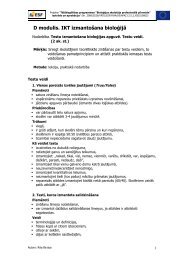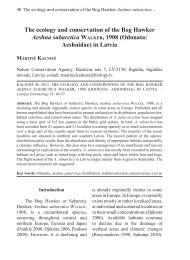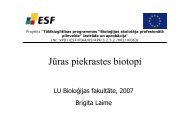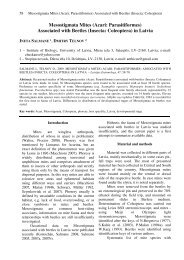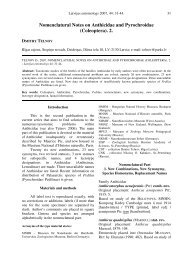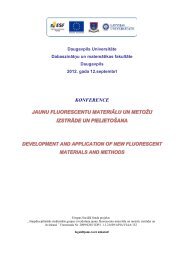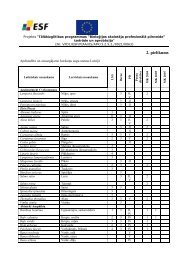306 L. Davies et al. / Environmental Pollution 146 (2007) 299e310latter is now abundant at roadside sites <strong>of</strong> medium traffic flow(James <strong>and</strong> Davies, 2005) <strong>and</strong> is also associated with pollution,although not specifically N or S compounds (Dobson, 2004).3.2.4. M<strong>in</strong>imum temperature <strong>and</strong> ra<strong>in</strong>fallLichen <strong>sensitivity</strong> <strong>to</strong> urban environments is well documented(Copp<strong>in</strong>s, 1973). Temperatures <strong>in</strong> <strong>London</strong> rema<strong>in</strong> 2e3 Cwarmer <strong>in</strong> the city centre <strong>and</strong> <strong>in</strong>ner suburbs throughout theyear, although temperatures <strong>in</strong> central <strong>London</strong> occasionallyfall below zero. Annual average relative humidity <strong>in</strong> <strong>London</strong>(measured at <strong>London</strong> Heathrow) varied between 73% <strong>and</strong>82% over a 27-year period (D.R. Middle<strong>to</strong>n, pers. commun.),slightly below that suggested for optimum lichen metabolismfor green algae (Nash, 1997), <strong>and</strong> <strong>in</strong> central <strong>London</strong> averaged62% dur<strong>in</strong>g August <strong>and</strong> September 2004 (A. Hudson-Smith,pers. commun.). Ra<strong>in</strong>fall fluctuates year on year, but is lower<strong>in</strong> the centre <strong>of</strong> <strong>London</strong>. Species associated with areas <strong>of</strong> highra<strong>in</strong>fall were Dimerella p<strong>in</strong>eti, Lecidella scabra <strong>and</strong> the mossEurhynchium praelongum. Species associated with low ra<strong>in</strong>fall<strong>and</strong> m<strong>in</strong>imum temperature were generally the most pollution<strong>to</strong>lerant (Fig. 3).3.2.5. Acid bark <strong>and</strong> girthThe CCA analysis identified a positive relationshipbetween the follow<strong>in</strong>g species <strong>and</strong> acid bark: Anisomeridiumbiforme, Strangospora p<strong>in</strong>icola, Hypogymnia physodes, Everniaprunastri, Ramal<strong>in</strong>a far<strong>in</strong>acea, Lepraria <strong>in</strong>cana <strong>and</strong>Parmotrema ch<strong>in</strong>ense. Most are classified as acidophytes(van Herk, 2002) <strong>and</strong> were not associated with transportpollution.Records <strong>of</strong> acidophytes (Hawksworth <strong>and</strong> Rose, 1970; vanHerk, 2002) have cont<strong>in</strong>ued <strong>to</strong> decl<strong>in</strong>e (Bates et al., 2001)<strong>and</strong> for some species distribution was relatively low (abundance<strong>in</strong> brackets) (Fig. 5): A. Lecanora conizaeoides (30),B. Hypogymnia physodes (30), but not for all: C. Everniaprunastri (94), D. Lepraria <strong>in</strong>cana (102).Fig. 5. Distribution <strong>of</strong> species associated with acidity: (a). Lecanoraconizaeoides <strong>and</strong> (b). Hypogymnia physodes (both <strong>in</strong> decl<strong>in</strong>e); (c) Everniaprunastri<strong>and</strong> (d) Lepraria <strong>in</strong>cana (both widely distributed).Large girth was important <strong>in</strong> the second CCA ord<strong>in</strong>ationaxis for Strangospora p<strong>in</strong>icola, Physconia grisea, Physciacaesia <strong>and</strong> P. dubia, species associated with eutrophication<strong>and</strong> nutrient-rich dusts (Gilbert, 1976; James et al., 1977).Lecanora carp<strong>in</strong>ea, L. confusa <strong>and</strong> L. symmicta were widelyrecorded <strong>and</strong> demonstrated a preference for trees with a smallgirth. These species are more usually conf<strong>in</strong>ed <strong>to</strong> twigs, whichwere not sampled <strong>in</strong> this study.3.3. <strong>Diversity</strong> <strong>and</strong> EU limit valuesThe critical levels <strong>to</strong> protect sensitive vegetation <strong>and</strong>ecosystems were derived ma<strong>in</strong>ly from studies carried out onhigher plants <strong>and</strong> focus on the effects <strong>of</strong> NO 2 (WHO, 2000).More recent studies <strong>in</strong>vestigate a wider range <strong>of</strong> vegetation<strong>and</strong> the impact <strong>of</strong> other N compounds as well as transport emissionsgenerally (NEGTAP, 2001; Bell <strong>and</strong> Treshow, 2002; Bignalet al., 2004). Many different approaches have been applied<strong>to</strong> <strong>in</strong>vestigate the impact <strong>of</strong> NO x <strong>in</strong> both field studies <strong>and</strong> chamberfumigation studies (Fuentes <strong>and</strong> Rowe, 1998; Bell <strong>and</strong>Treshow, 2002; Gombert et al., 2002; Batty et al., 2003; Lorenz<strong>in</strong>iet al., 2003; Purvis et al., 2003, 2004). Fumigation studieson higher plants us<strong>in</strong>g s<strong>in</strong>gle <strong>and</strong> mixed transport emissionshave identified direct <strong>to</strong>xicity effects, enhanced growth <strong>and</strong>element accumulation with vary<strong>in</strong>g degrees <strong>of</strong> <strong>sensitivity</strong> fordifferent species (NEGTAP, 2001; Bignal et al., 2004). Nitrogen-compoundsalso contribute <strong>to</strong> acidification <strong>and</strong> eutrophication(NEGTAP, 2001). Some studies suggest that exposure <strong>to</strong>mo<strong>to</strong>r vehicle exhaust has little additional <strong>in</strong>fluence comparedwith exposure <strong>to</strong> NO x alone (Bignal et al., 2004).NO has been recognised as hav<strong>in</strong>g quite dist<strong>in</strong>ct effectsfrom those attributed <strong>to</strong> NO 2 <strong>and</strong> may be the more <strong>to</strong>xic component<strong>of</strong> NO x (Wellburn, 1990; Mansfield, 2002). It is also animportant signall<strong>in</strong>g mechanism <strong>in</strong> animal cell function(Mansfield, 2002) <strong>and</strong> <strong>in</strong> plant defence mechanisms.Effects <strong>of</strong> NO 2 on lichen physiology were first demonstratedat concentrations <strong>of</strong> 3760 mg m ÿ3 <strong>and</strong> 7562 mg m ÿ3 underlabora<strong>to</strong>ry conditions (Nash, 1976). Many studies showthat traffic emissions affect lichens from the cellular <strong>to</strong> communitylevel, although the fac<strong>to</strong>rs responsible are poorly unders<strong>to</strong>od(Nash, 1988; Von Arb <strong>and</strong> Brunold, 1990; Seaward<strong>and</strong> Copp<strong>in</strong>s, 2004). Angold (1997) reported the loss <strong>of</strong> terricolouslichens near roads <strong>in</strong> the New Forest <strong>and</strong> suggested thatcompetition from faster grow<strong>in</strong>g species was a contribu<strong>to</strong>ryfac<strong>to</strong>r. Nitrogen concentrations <strong>in</strong> Physcia adscendens grow<strong>in</strong>gadjacent <strong>to</strong> roads were found <strong>to</strong> <strong>in</strong>crease with proximity<strong>to</strong> roads <strong>of</strong> high traffic flow, but not <strong>in</strong> Hypogymnia physodes(Gombert et al., 2002). NO x was considered a possible fac<strong>to</strong>rprevent<strong>in</strong>g colonisation <strong>of</strong> Parmelia saxatilis adjacent <strong>to</strong> busyroads <strong>in</strong> central <strong>London</strong> (Batty et al., 2003). Traffic flow rateswere l<strong>in</strong>ked with dusts <strong>and</strong> enhanced <strong>nitrogen</strong> <strong>and</strong> z<strong>in</strong>c levels<strong>in</strong> Parmelia sulcata <strong>and</strong> identified as a fac<strong>to</strong>r contribut<strong>in</strong>g <strong>to</strong>its poor health <strong>in</strong> Burnham Beeches, west <strong>of</strong> <strong>London</strong> (Purviset al., 2003, 2004). NO 2 derived from traffic emissions limitedlichen diversity (expressed as an Index <strong>of</strong> Atmospheric Purity‘‘IAP’’) <strong>in</strong> Seville, Spa<strong>in</strong> (Fuentes <strong>and</strong> Rowe, 1998) <strong>and</strong> <strong>in</strong>Tuscany, Italy (expressed as a lichen biodiversity value,
L. Davies et al. / Environmental Pollution 146 (2007) 299e310307Lorenz<strong>in</strong>i et al., 2003). NO x derived from domestic heat<strong>in</strong>gemissions was considered responsible for changes <strong>in</strong> diversityat Pis<strong>to</strong>ia, Italy (Loppi <strong>and</strong> Cors<strong>in</strong>i, 2003).Further evidence <strong>of</strong> vary<strong>in</strong>g <strong>sensitivity</strong> <strong>to</strong> transport emissions<strong>and</strong> NO x was found <strong>in</strong> Xanthoria pariet<strong>in</strong>a which wasunharmed follow<strong>in</strong>g exposure <strong>to</strong> high traffic emissions, unlikethe more sensitive Ramal<strong>in</strong>a duriaei, which showed extensivephysiological changes (Silberste<strong>in</strong> et al., 1996a,b). A superiorresponse by X. pariet<strong>in</strong>a <strong>to</strong> oxidative stress was identified asa key fac<strong>to</strong>r. Other studies have reported antioxidant responses<strong>in</strong> lichens follow<strong>in</strong>g exposure <strong>to</strong> NO x ,SO 2 <strong>and</strong> ozone (Bates,2002; Cuny et al., 2002).There is much empirical evidence from field studies l<strong>in</strong>k<strong>in</strong>gmany <strong>of</strong> the pollution <strong>to</strong>lerant lichens <strong>to</strong> <strong>nitrogen</strong> (Barkman,1958; James et al., 1977; Seaward <strong>and</strong> Copp<strong>in</strong>s, 2004; Davies,2005). Labora<strong>to</strong>ry-based studies have recorded high N accumulationwith<strong>in</strong> the thalli <strong>of</strong> many species (Purvis et al., 2003,2004; Gaio-Oliveira et al., 2004; Gombert et al., 2002). Theseassociations led <strong>to</strong> the term ‘‘nitrophyte’’. A scale <strong>of</strong> <strong>sensitivity</strong><strong>to</strong> ammonia was devised, although it was later found that barkpH was the ma<strong>in</strong> fac<strong>to</strong>r affect<strong>in</strong>g changes <strong>in</strong> community structureon oak (van Herk, 2002). Conversely, some species arehighly sensitive <strong>to</strong> N <strong>and</strong> prefer a more acidic environment.High deposition <strong>of</strong> <strong>nitrogen</strong> can be directly <strong>to</strong>xic <strong>to</strong> terricolouslichens <strong>and</strong> mosses <strong>of</strong> heathl<strong>and</strong> areas <strong>and</strong> some <strong>epiphytes</strong>(Pitcairn et al., 1991; van Herk, 2001; Massara, 2004).Whilst the focus <strong>of</strong> this study is NO x , it is recognised thatmany other pollutants are associated with transport. In particularammonia <strong>and</strong> ammonium compounds as well as dusts,heavy metals, VOCs <strong>and</strong> PAHs, may be contribut<strong>in</strong>g <strong>to</strong> theresults. In addition, the modelled data, although validatedaga<strong>in</strong>st actual measurements, may occasionally over- orunder-estimate NO x . Furthermore, urban environments areless humid <strong>and</strong> warmer than rural areas which will restrict distribution.In addition, record<strong>in</strong>g was conf<strong>in</strong>ed <strong>to</strong> Frax<strong>in</strong>usexcelsior, a neutral bark tree species. These fac<strong>to</strong>rs must betaken <strong>in</strong><strong>to</strong> consideration when summaris<strong>in</strong>g the results <strong>of</strong>this study, as well as the avoidance <strong>of</strong> trees without <strong>epiphytes</strong>.Lichen diversity <strong>in</strong> <strong>London</strong> has <strong>in</strong>creased by an order <strong>of</strong>magnitude s<strong>in</strong>ce the 1970s (Laundon, 1970) (Fig. 6). Muchcan be attributed <strong>to</strong> reductions <strong>in</strong> SO 2 <strong>and</strong> acidity (Hawksworth,2002), but this study shows that the number <strong>of</strong> lichens<strong>in</strong> many <strong>of</strong> the central <strong>London</strong> Boroughs is now significantlyhigher than <strong>in</strong> some outer <strong>London</strong> Boroughs (Fig. 6). This islargely expla<strong>in</strong>ed by the distribution <strong>of</strong> the pollution <strong>to</strong>lerantspecies, many <strong>of</strong> which are also associated with eutrophication.Few rare species were found; some not seen <strong>in</strong> <strong>London</strong>for decades have returned <strong>and</strong> others are new records for theCapital (Waterfield, 2002). In areas <strong>of</strong> highest NO x , species recordedbelong almost exclusively <strong>to</strong> the families C<strong>and</strong>elariaceae,Physciaceae <strong>and</strong> Teloschistaceae. Further evidence <strong>of</strong> theunremarkable flora is provided by the presence <strong>of</strong> just tw<strong>of</strong>ruticose species, Ramal<strong>in</strong>a far<strong>in</strong>acea <strong>and</strong> Usnea cornuta,the latter with a thallus length not exceed<strong>in</strong>g 1.5 cm.Three <strong>of</strong> the most widely distributed species, Xanthoriac<strong>and</strong>elaria group, X. pariet<strong>in</strong>a <strong>and</strong> X. polycarpa, are characterisedby the presence <strong>of</strong> pariet<strong>in</strong>, an antioxidant anthraqu<strong>in</strong>one(Søcht<strong>in</strong>g <strong>and</strong> Lutzoni, 2003), which is the pigment that(a)(b)EnfieldEnfieldBarnetBarnetHarrowWaltham ForestHar<strong>in</strong>geyRedbridgeHarrowWaltham ForestHar<strong>in</strong>geyRedbridgeHill<strong>in</strong>gdonBrentHackneyCamdenIsl<strong>in</strong>g<strong>to</strong>n parkNewhamEal<strong>in</strong>gTowerWestm<strong>in</strong>ster City HamletsKens<strong>in</strong>g<strong>to</strong>nHammersmithGreenwichHounslowSouthwarkLambethW<strong>and</strong>sworthLewishamBark<strong>in</strong>gBexleyHaver<strong>in</strong>gHill<strong>in</strong>gdonBrentHackneyCamdenIsl<strong>in</strong>g<strong>to</strong>n parkNewhamEal<strong>in</strong>gCityTower HamletsKens<strong>in</strong>g<strong>to</strong>nWestm<strong>in</strong>sterHammersmithSouthwarkGreenwichHounslowLambethW<strong>and</strong>sworthLewishamBark<strong>in</strong>gBexleyHaver<strong>in</strong>gRichmondMer<strong>to</strong>nRichmondMer<strong>to</strong>nK<strong>in</strong>gs<strong>to</strong>nSut<strong>to</strong>nCroydonBromleyK<strong>in</strong>gs<strong>to</strong>nSut<strong>to</strong>nCroydonBromley1970LICHENS2004LICHENS0 - 128 - 1415 - 233 - 424 - 355 - 736 - 47EXCLUDEDEXCLUDEDFig. 6. (a). Lichen diversity on trees, 1970. (b) Lichen diversity on Frax<strong>in</strong>us excelsior, 2004.



